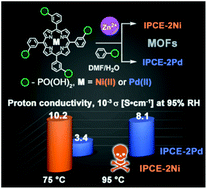Proton conductivity as a function of the metal center in porphyrinylphosphonate-based MOFs†
Abstract
The rational design of metal–organic frameworks (MOFs) is highly important for the development of new proton conductors. Porphyrinylphosphonate-based MOFs, providing the directed tuning of physical and chemical properties of materials through the modification of a macrocycle, are potentially high-conducting systems. In this work the synthesis and characterization of novel anionic Zn-containing MOF based on palladium(II) meso-tetrakis(3-(phosphonatophenyl))porphyrinate, IPCE-2Pd, are reported. Moreover, the proton-conductive properties and structures of two anionic Zn-containing MOFs based on previously described nickel(II) and novel palladium(II) porphyrinylphosphonates, IPCE-2M (M = Ni(II) or Pd(II)), are compared in details. The high proton conductivity of 1.0 × 10−2 S cm−1 at 75 °C and 95% relative humidity (RH) is revealed for IPCE-2Ni, while IPCE-2Pd exhibits higher hydrolytic and thermal stability of the material (up to 420 °C) simultaneously maintaining a comparable value of conductivity (8.11 × 10−3 S cm−1 at 95 °C and 95% RH). The nature of the porphyrin metal center is responsible for the features of crystal structure of materials, obtained under identical reaction conditions. The structures of IPCE-2Pd and its dehydrated derivative IPCE-2Pd-HT are determined from the synchrotron powder diffraction data. The presence of phosphonic groups in compared materials IPCE-2M affords a high concentration of proton carriers that together with the sorption of water molecules leads to a high proton conductivity.



 Please wait while we load your content...
Please wait while we load your content...